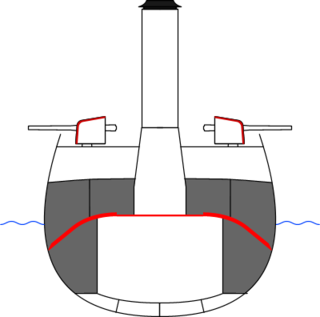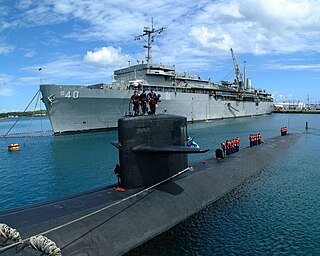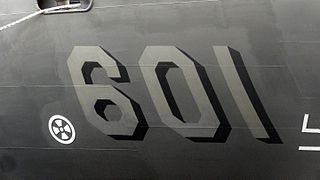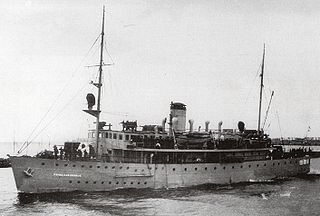
The Royal Netherlands Navy is the naval force of the Kingdom of the Netherlands. Its origins date back to the Eighty Years' War (1568–1648), the war of independence from the House of Habsburg who ruled over the Habsburg Netherlands.

Protected cruisers, a type of naval cruiser of the late-19th century, gained their description because an armoured deck offered protection for vital machine-spaces from fragments caused by shells exploding above them. Protected cruisers resemble armored cruisers, which had in addition a belt of armour along the sides.

A submarine tender is a type of depot ship that supplies and supports submarines.
Hydra generally refers to:

In the Royal Navy and other navies of Europe and the Commonwealth of Nations, ships are identified by pennant number. Historically, naval ships flew a flag that identified a flotilla or type of vessel. For example, the Royal Navy used a red burgee for torpedo boats and a pennant with an H for torpedo boat destroyers. Adding a number to the type-identifying flag uniquely identified each ship.

The S and T class was a class of sixteen destroyers of the Royal Navy launched in 1942–1943. They were built as two flotillas, known as the 5th and 6th Emergency Flotilla, and they served as fleet and convoy escorts in World War II.

The Java class was a class of light cruisers of the Royal Netherlands Navy, named after the island of Java in the Dutch East Indies. Originally, three ships were planned: Java, Sumatra, and Celebes. Celebes was intended to be the flagship of the naval commander in the Dutch East Indies, and therefore she was slightly bigger than the other two ships. However, the contract was cancelled with 30 tons of material already prepared.

Coastal defence ships were warships built for the purpose of coastal defence, mostly during the period from 1860 to 1920. They were small, often cruiser-sized warships that sacrificed speed and range for armour and armament. They were usually attractive to nations that either could not afford full-sized battleships or could be satisfied by specially designed shallow-draft vessels capable of littoral operations close to their own shores. The Nordic countries and Thailand found them particularly appropriate for their island-dotted coastal waters. Some vessels had limited blue-water capabilities; others operated in rivers.
Foreign U-boats was the title for a special section created by Nazi Germany's Kriegsmarine that adopted 13 captured enemy submarines and a single Turkish vessel into the U-boat corps. Beginning in 1939 and lasting until the end of World War II in 1945, the Kriegsmarine modified a total of 13 captured enemy submarines, then deployed them into combat with German crews. The special corps was not especially successful, as only nine enemy ships were destroyed by Foreign U-boats through the entire war. Seven of these were destroyed by UA, which was a modified Type IX U-boat originally built for the Turkish Navy. However, some were effective as minelayers.

HNLMS Zwaardvisch (S814) was the lead ship of the Royal Netherlands Navy's Zwaardvisch-class submarine, which was based on the British T class. The submarine was originally ordered as HMS Talent (P322) and built by Vickers Armstrong, Barrow, and John Brown & Company, Clydebank. It served mainly in the Pacific against the Japanese during the war, operating under both British and US operational command in Ceylon and Australia. In 1950, the vessel was renamed HNLMS Zwaardvis. She was sold and broken up for scrap in 1963.

The Douwe Aukes class were two minelayers of the Royal Netherlands Navy. The two ships were built at the Gusto shipyard in Schiedam. Construction began in 1919 and was completed in 1922. Built to serve in the Dutch territorial waters, both ships were still in service during the Second World War and they both escaped to the United Kingdom, HNLMS Douwe Aukes on 14 May and HNLMS Van Meerlant on 18 May 1940. Both vessels were transferred to the British Royal Navy. Van Meerlant was sunk by a mine in 1942 while in British service. Douwe Aukes was returned to the Royal Netherlands Navy following the war and was used as a depot ship until sold for scrap in 1962.

The Prins van Oranje class were two minelayers of the Royal Netherlands Navy, built to serve in the Dutch East Indies. The construction of the ships began in 1930 and was completed in 1932. The ships were built by the De Maas shipyard in Slikkerveer. Both ships were still in service during the Second World War. Both ships were stationed in the Dutch East Indies, and both ships were lost in the war with Japan.

HNLMS Douwe Aukes was a minelayer of the Royal Netherlands Navy. She was built in the Gusto shipyard at Schiedam as the lead ship of the Douwe Aukes class, and one of her early commanders was Eugène Lacomblé.

HNLMS Van Meerlant was a minelayer of the Royal Netherlands Navy built in the Gusto shipyard at Schiedam as part of the Douwe Aukes class.

HNLMS Medusa was a Dutch Hydra-class minelayer, built in Amsterdam and named after Medusa in Greek mythology.
HNLMS Medusa may refer to:

The O 19 class was a class of two submarines, built for the Royal Netherlands Navy by Fijenoord, Rotterdam. The ships were designed as submarine minelayer for operations in both European and colonies waters. The class comprised O 19 and O 20 and were the first submarines in the world to be equipped with a submarine snorkel that allowed the submarine to run its diesel engines while submerged. The submarines diving depth was 100 m (330 ft). These units were very similar to earlier Polish Orzeł class, with a reduced torpedo battery and 10 vertical mine tubes fitted on each beam.

HNLMS Friesland is a Holland-class offshore patrol vessel operated by the Royal Netherlands Navy. The ship entered service on 22 January 2013 and is named after the Dutch province of Friesland.
HMS Medusa was a Medea-class destroyer of the British Royal Navy. She was one of four destroyers, of similar design to the British M-class ordered by Greece in June 1914, which the British purchased during construction owing to the outbreak of the First World War.
This page is based on this
Wikipedia article Text is available under the
CC BY-SA 4.0 license; additional terms may apply.
Images, videos and audio are available under their respective licenses.














